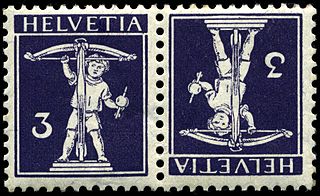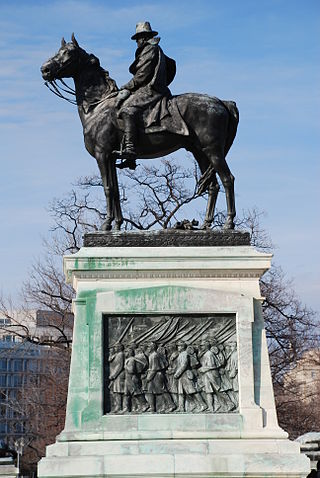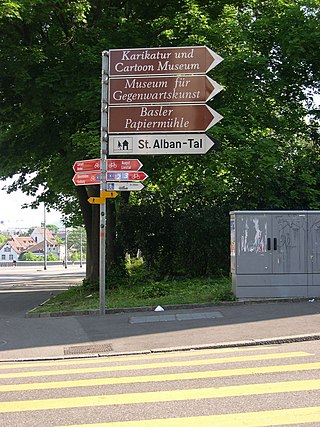
This is a survey of the postage stamps and postal history of Switzerland.

Helvetia is the female national personification of Switzerland, officially Confoederatio Helvetica, the Swiss Confederation.

The Ulysses S. Grant Memorial is a presidential memorial in Washington, D.C., honoring American Civil War general and 18th United States President Ulysses S. Grant. It sits at the base of Capitol Hill, below the west front of the United States Capitol. Its central sculpture of Grant on horseback faces west, overlooking the Capitol Reflecting Pool and facing toward the Lincoln Memorial, which honors Grant's wartime president, Abraham Lincoln. Grant's statue is raised on a pedestal decorated with bronze reliefs of the infantry; flanking pedestals hold statues of protective lions and bronze representations of the Union cavalry and artillery. The whole is connected with marble covered platforms, balustrades, and stairs. The Grant and Lincoln memorials define the eastern and western ends, respectively, of the National Mall.

Richard Kissling was a Swiss sculptor, and medallist.

Johann Rudolf Wettstein was a Swiss diplomat and mayor of Basel, who achieved fame through his diplomatic skills, culminating in Swiss independence from the Holy Roman Empire in 1648.

The Basel museums encompass a series of museums in the city of Basel, Switzerland, and the neighboring region. They represent a broad spectrum of collections with a marked concentration in the fine arts and house numerous holdings of international significance. With at least three dozen institutions, not including the local history collections in the surrounding communities, the region offers an extraordinarily high density of museums compared to other metropolitan areas of similar size. They draw some one and a half million visitors annually.

The coins of the Swiss franc are the official coins used in Switzerland and Liechtenstein. The name of the subunit is centime in French and internationally, Rappen in German, centesimo in Italian, and rap in Romansh. There are coins in denominations of 5 centimes, 10 centimes, 20 centimes, 1⁄2 franc, 1 franc, 2 francs, and 5 francs.

A shooting thaler is a silver coin in thaler size minted to commemorate a Schützenfest or free shooting in Switzerland.
The following is a timeline of the history of the city of Basel.
Helvetia is a globally active Swiss insurance group. The group of companies has been organised in a holding structure since 1996. The head office of Helvetia Group is located in St Gallen.

Commodore Oliver Hazard Perry Monument is a war monument in Cleveland, Ohio that commemorates Oliver Hazard Perry and his victory at the Battle of Lake Erie in the War of 1812. Erected at the center of the city's Public Square in 1860, its Perry statue by sculptor William Walcutt was Ohio's first monumental sculpture.

The Middle Bridge is a historic bridge in the Swiss city of Basel. It is situated on the oldest existing bridge site across the Rhine, between Lake Constance and the North Sea.

The Fussball Club Basel 1893 1993–94 season was their 101st season since the club's foundation. Peter Epting was the club's chairman for the second period. FC Basel played their home games in the St. Jakob Stadium. Following their relegation in the 1987–88 season this was their sixth season in the second tier of Swiss football.

Lukas Ferdinand Schlöth was a Swiss sculptor in the late Classical style.

Karl Gustav Jung was a German-Swiss medical doctor, political activist, professor of Medicine at the University of Basel, administrator and freemason.

The Winkelried memorial was erected in memory of Arnold von Winkelried, who sacrificed his life in the Battle of Sempach on the 9 July 1386. According to the Swiss historiography, the Swiss wouldn't be able to break through the firmly positioned order of Habsburg pikemen. At a moment, Winkelried decided to throw himself into the pikes and therefore open a passage through the Austrian defensive front, which made way for an attack of the Swiss confederacy which then led to a Swiss victory in the Battle of Sempach.

The Strassburger memorial is a monument in Basel established in memory of the help the civil population of Strassburg received from Switzerland during the Franco-Prussian war in 1870-1871. It was modeled by Frédéric Auguste Bartholdi and is located in a park across from the Basel railway station.

Hieronymus Hess was a Swiss painter and artist from Basel.
Georg Schmidt was a Swiss art historian. He was director of the Kunstmuseum Basel from 1939 to 1961.

















